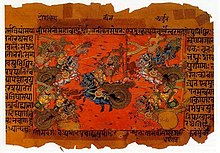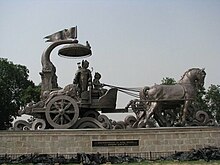Kurukshetra  pronunciation (help·info) (Hindi: कुरुक्षेत्र) is a land of historical and religious importance. Historically the land belonged to Punjab now a district in Haryana state of India. It is a holy place and is also known as Dharmakshetra ("Holy City"). According to the Puranas, Kurukshetra is named after King Kuru, the ancestor of Kauravas and Pandavas, as depicted in epic Mahabharata. The importance of the place is attributed to the fact that the Kurukshetra War of the Mahabharata was fought on this land and the Bhagavad Gita was preached on this land during the war when Lord Krishna found Arjuna in a terrible dilemma.[1]
pronunciation (help·info) (Hindi: कुरुक्षेत्र) is a land of historical and religious importance. Historically the land belonged to Punjab now a district in Haryana state of India. It is a holy place and is also known as Dharmakshetra ("Holy City"). According to the Puranas, Kurukshetra is named after King Kuru, the ancestor of Kauravas and Pandavas, as depicted in epic Mahabharata. The importance of the place is attributed to the fact that the Kurukshetra War of the Mahabharata was fought on this land and the Bhagavad Gita was preached on this land during the war when Lord Krishna found Arjuna in a terrible dilemma.[1]
Rashtrakavi Ramdhari Singh 'Dinkar' has written an epic poem by the title of Kurukshetra. It is a narrative poem based on the Santi Parvaof the Mahabharata.[2] It was written at a time when the memories of the Second World War were fresh on the mind of the poet.[2]
Thanesar or Sthaneswar is a historical town located adjacent to what is now the newly created Kurukshetra city. Thanesar derives its name from the word "Sthaneshwar", which means "Place of God". The Sthaneshwar Mahadev Temple, whose presiding deity is Lord Shiva, is believed to be the oldest temple in the vicinity. Local hearsay identifies the legendary "Kurukshetra" with a nearby place known as Thanesar. A few kilometeres from Kurukshetra is the village known as Amin, where there are remnants of a fort which is believed to beAbhimanyu's fort.
In some ancient Hindu texts, the boundaries of Kurukshetra correspond roughly to the state of Haryana. Thus according to the Taittiriya Aranyaka 5.1.1., the Kurukshetra region is south of Turghna (Srughna/Sugh in Sirhind, Punjab), north of Khandava (Delhi and Mewatregion), east of Maru (desert) and west of Parin.[3]
History
It is written in Puranas that Kurukshetra is named after King Kuru of the Bharata Dynasty, ancestor of Pandavas and Kauravas.
The Vamana Purana tells how King Kuru came to settle on this land. He chose this land at the banks of Sarasvati River for embedding spirituality with 8 virtues: austerity (tapas), truth (satya), forgiveness (kshama), kindness (daya), purity (sucha), charity (dana), yagya andbrahmacharya. Lord Vishnu was impressed with the act of King Kuru and blessed him. God gave him two boons, one that this land forever will be known as a Holy Land after his name as Kurukshetra (the land of Kuru) and the other that anyone dying on this land will be going to heaven. The land of Kurukshetra was situated between two rivers — the Sarasvati and the Drishadvati.
This land has been known as Uttravedi, Brahmavedi, Dharamkshetra and Kurukshetra at different periods. When King Kuru came on this land it was called Uttarvedi. Over the period this land has been ruled by many empires. The Bharata Dynasty came and settled on this land.
Later the Battle of Mahabharata was fought on this land, during which Lord Krishna preachedBhagavad Gita to Arjuna.
It reached the zenith of its progress during the reign of King Harsha, during which Chinese scholar Hieun Tsang visited this land at Thanesar. By the archaeological grounds it has been proved that Ashoka the Great made Kurukshetra a centre of learning for people from all over the world.
[edit]Places of interest
- Brahma Sarovar: Every year lakhs of people come to take a holy bath at Brahma Sarovar on the occasion of "Somavati Amavasya" (Sacred No-Moon Day that happens on a Monday) and on solar eclipse believing that a bath in holy sarovar frees all sins and cycle of birth-death.
- Sannihit Sarovar: This sarovar is believed to be the meeting point of seven sacred Saraswatis. The sarovar, according to popular belief, contains sacred water. Bathing in the waters of the tank on the day of Amavasya (night of complete darkness) or on the day of an eclipse bestows blessings equivalent to performing the ashvamedh yajna.
- Jyotisar: The famous site where Bhagavad Gita was delivered to Arjuna
- Krishna Museum has some historical artifacts and paintings depicting the Mahabharata war.
- Kurukshetra Panorama and Science Centre: A world-class panorama depicting the Mahabharata war with scientific explanations justifying every episode in the war. There are also several scientific exhibits designed to kindle a curiosity for science.
- Kalpana Chawla Planetarium
- Kessel Mall: A shopping mall cum multiplex at sector 17 for food, shopping and entertainment.
- Light and Sound Show: A newly built tourist attraction which highlights some aspects of Geeta Saar through lights and sound.
- Dharohar: A must visit to know the tradition and culture of Haryana; located in Kurukshetra University.
- Bhishma Kund at Naraktari: The place where Arjuna shot an arrow towards the earth to quench Bhisma Pitamah's thirst.
- Saraswati Forest Reserve: It is a large reserved forest area with rich flora and fauna in Kurukshetra district.
- Sheikh Chehli ka makbara (tomb): This monument is maintained by the Archeological Survey of India. It was built during the Mughal era in remembrance of Sufi Saint Sheikh Chehli, believed to be the spiritual teacher of Mughal Prince Dara Shikoh. However, this is an erroneous belief, since the Prince's main 'Murshid' or 'Sheikh' (Spiritual Guide) is historically known to have been Hazrat Sheikh Mian Mir Sahib, of Lahore,[4] although Sheikh Chehli might have been an additional/minor guide. There is another theory that the site of the supposed 'makbara' or tomb was one of the meditative 'Chillas' or sites of Hazrat Mian Mir Sahib, who might have visited the area during his wanderings.[5] It is possible that a later caretaker, some disciple of the Hazrat/Sheikh lies buried here, at the place sanctified by his 'Chilla'.
- Sthaneshwar Mahadev
- Kamal Nabhi
- Valmiki Ashram
- Birla Mandir
- Gurdwara Raj Ghat Patshahi Dasvin
- Gurdwara Teesari Patshahi
- Gurdwara Chhevin Patshahi
- Gurdwara Siddh Bati Patshahi Pahili
- Pehowa
- Ban Ganga in villag: A temple that is one of the 52 Shakti Peethas. As per the story in Hindu mythology, the goddess Sati killed herself by entering the Yagna of Raja Daksha as a protest against the insult of Lord Shiva. Remorseful Lord Shiva wandered across the whole universe with the corpse of his beloved Sati on his shoulder. To bring him back to the original mood, it was necessary to destroy the corpse of Sati. Lord Vishnu hence cut the corpse in 52 pieces with his Sudarshana Chakra. The parts fell at different places where the temples of the goddess were later built by the devotees. Collectively, these are known as the 52 Shakti Peethas. One of them is in Kurukhsetra, where the ankle of the goddess fell.
[edit]Jhansa
Jhansa is a village in the Kurukshetra district. It is known for its river and canals, and the Markanda temple, built on the banks of the Markanda River.
There is a beautiful scenic view in the village where SYL Bhakhra Canal and Markanda River intersects. In the summer you can have a chilling bath in Gulla Canal and Bhakhra Canal.




No comments:
Post a Comment